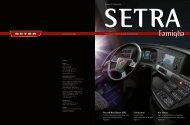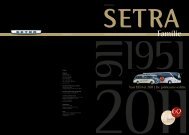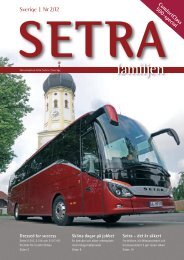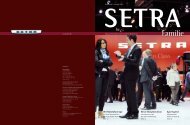Family - Setra
Family - Setra
Family - Setra
Create successful ePaper yourself
Turn your PDF publications into a flip-book with our unique Google optimized e-Paper software.
10 | <strong>Setra</strong> Cover Story<br />
<strong>Setra</strong> Cover Story | 11<br />
B<br />
eginning in January 2014, the new Euro VI emission standard<br />
will call for dramatically reduced emissions. The only<br />
problem is that lowering harmful emissions almost automatically<br />
increases fuel consumption and therefore costs. For the<br />
new ComfortClass 500 with a Euro VI engine, the greatest challenge<br />
was to reduce the emission of soot particles and nitrogen oxides,<br />
while setting all-new standards in cost-effectiveness.<br />
The ultimate consumption test<br />
To achieve this ambitious goal, the ComfortClass 500’s new Blue-<br />
Efficiency engine generation plays a key role – by uniquely combining<br />
innovative technology and intelligent exhaust after-treatment.<br />
Along with the use of cooled exhaust gas recirculation (EGR), the<br />
engine relies on Mercedes-Benz’ BlueTec 6 technology, in which a<br />
closed particulate filter and the successful SCR system complement<br />
each other perfectly.<br />
Other important measures in the vehicle’s development were the<br />
lowering of air resistance by 20% and a significant reduction in<br />
weight – which of course has an additional positive effect on fuel.<br />
Internal <strong>Setra</strong> calculations indicated that the new Comfort-<br />
Class 500 with Euro VI should consume 5—6% less fuel than its<br />
predecessor, the ComfortClass 400 with Euro V. So far, all the<br />
basic requirements for a fuel-efficient vehicle, right? But how<br />
does the ComfortClass 500’s actual fuel consumption fare under<br />
absolutely realistic conditions?<br />
The Record Run Buses 2012 fuel comparison test from last October<br />
was intended to provide irrefutable proof that fuel economy is possible<br />
in spite of Euro VI. In this test drive, under everyday driving<br />
conditions, the ComfortClass 500 with Euro VI and the Comfort-<br />
Class 400 with Euro V were pitted against each other. And, to guarantee<br />
that the results of the Record Run Buses 2012 would be 100<br />
percent reliable, while delivering clear messages to <strong>Setra</strong> customers<br />
regarding fuel consumption, the project responsibles at <strong>Setra</strong> looked<br />
for a suitable partner. One that would embody technical expertise,<br />
strict neutrality and unconditional diligence. DEKRA, the renowned<br />
international testing, inspection and certification provider, fit the<br />
bill perfectly.<br />
DEKRA as neutral supervisory authority<br />
DEKRA is one of the world’s leading expert organisations, active in<br />
more than 50 countries. Close to 27,000 employees worldwide look<br />
after the key areas of vehicle inspections, appraisals, industrial<br />
testing services, product testing, certification and environmental<br />
protection. DEKRA teams from several different locations took part<br />
in the Record Run Buses 2012 event. The DEKRA Wiesbaden office<br />
was involved in the early planning phase and contributed their expertise<br />
to the professional preparation of the vehicles. To ensure the<br />
most transparent, certified testing, the engineers sealed all components<br />
essential for fuel consumption on both vehicles – including of<br />
course, the fuel tanks themselves. “Only when any possibility of<br />
manipulation is excluded a priori, can we assume that consumption<br />
levels are absolutely binding and watertight,” explains Bernd<br />
Pisecky, an engineer at the DEKRA office in Leipzig.<br />
Identical starting conditions – to millimetre accuracy!<br />
The DEKRA experts paid particular attention to having the two coaches<br />
take to the starting block under identical competitive conditions. The<br />
coaches were weighed – as in a boxing match. And both were fully<br />
loaded to the allowable total vehicle weight of 18 tonnes. The S 515 HD,<br />
with the new Mercedes-Benz OM 470 Euro VI engine, was pitted<br />
against the previous comparable model, the ComfortClass 400<br />
S 415 GT-HD with the previous OM 457 LA engine. Both vehicles<br />
competed with exactly the same horsepower of 315 kW (428 hp). And,<br />
finally, they were previously “broken in” with about 10,000 km.

















